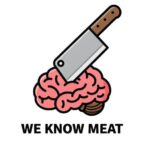When it comes to making beef jerky, not all cuts of beef are created equal. The best jerky starts with the right foundation: lean meat with just enough tenderness to absorb marinades and dry evenly. Too much fat leads to spoilage, and overly tough meat results in a poor chewing experience.
If you’ve ever wondered what the top 10 cuts of beef for making beef jerky are, you’re in the right place. In this guide, we rank the best beef cuts based on tenderness and low typical fat percentage—two essential qualities for producing high-quality, long-lasting jerky.
Let’s dive into the countdown.
10. Tri-Tip
• Tenderness: Medium-High
• Fat Content: Medium
Starting off our list is tri-tip, a flavorful cut from the bottom sirloin. It has great beefy taste and a decent chew but can hide small pockets of fat. You’ll need to trim it well to get the most out of it.
Best for: Artisan jerky or smoked jerky with a bold flavor.
Watch out: Not ideal for shelf-stable jerky due to marbling and fat.
9. Top Sirloin
• Tenderness: High
• Fat Content: Medium
Top sirloin is flavorful and surprisingly tender, making it a favorite for those who like a more steak-like jerky. However, its higher fat content means it’s better suited for fresh jerky that will be eaten quickly.
Ideal for: Small-batch jerky where flavor and texture take priority.
8. Chuck Eye (Trimmed)
• Tenderness: High
• Fat Content: Medium
The chuck eye is rich and juicy but requires aggressive trimming. When properly cleaned up, it produces a succulent, tender jerky. Just be aware that it’s not a good choice for long storage without refrigeration.
Use it for: Immediate consumption or refrigerated jerky.
7. Brisket Flat (Lean Side)
• Tenderness: High
• Fat Content: Medium-Low (when trimmed well)
The brisket flat offers rich, smoky flavor and a soft bite when sliced thin. While brisket is often associated with fattiness, the flat can work well if you take time to trim it properly.
Use it when: You want a gourmet jerky experience with a unique texture.
6. London Broil (Top Round or Shoulder Labeling)
• Tenderness: Medium
• Fat Content: Low
Often sold as top round, London broil is a lean and easy-to-find option. It’s great for slicing into long, thin jerky strips. Be sure to inspect and trim for any hidden fat.
Pro tip: Slice it thin and marinate overnight for a savory, chewy result.
5. Flank Steak
• Tenderness: Medium-Tough
• Fat Content: Low
Known for its long grain and robust beefy flavor, flank steak makes jerky with an assertive chew and satisfying bite. It’s lean and slices beautifully against the grain.
Ideal for: Fans of chewy, flavorful jerky who don’t mind paying a bit more.
4. Sirloin Tip (Knuckle)
• Tenderness: Medium
• Fat Content: Low
The sirloin tip, also known as the knuckle, is lean and slightly more tender than the round cuts. It’s a fantastic middle-ground option for jerky lovers looking for something cost-effective yet high quality.
Best used for: Bulk jerky batches with minimal trimming required.
3. Bottom Round
• Tenderness: Medium-Firm
• Fat Content: Low
This cut is slightly tougher than top round but just as lean. It produces a traditional jerky texture with a hearty chew that purists appreciate.
Use it if: You want classic jerky feel and good value.
2. Top Round
• Tenderness: Medium
• Fat Content: Low
A favorite among commercial jerky makers, top round is lean, flavorful, and easy to work with. It’s often available in larger slabs, making it efficient for high-volume slicing and drying.
What makes it great: Predictable texture, low cost, and consistent results.
1. Eye of Round
• Tenderness: Medium
• Fat Content: Very Low
Topping the list of top 10 cuts of beef for making beef jerky is the unbeatable eye of round. Cut from the rear leg, it’s ultra-lean, firm, and uniform—everything you want in a jerky cut. Its fine grain and consistent shape make it easy to slice into perfect jerky strips.
Why it’s #1:
• Extremely low fat = longer shelf life
• Easy to trim and slice
• Affordable and widely available
• Great texture when sliced against the grain
What Makes a Cut Great for Jerky?
To make top-tier jerky, your beef needs to check two boxes:
1. Low Fat Content – Fat doesn’t dehydrate well and leads to spoilage.
2. Moderate Tenderness – Too tough makes it unpleasant to chew; too tender can make jerky fall apart.
Lean muscle fibers with minimal connective tissue are ideal. Marinate thoroughly, slice against the grain, and use a dehydrator or low-temp oven for even drying.
Cuts to Avoid
These cuts may be great for grilling or roasting, but they’re poor fits for jerky:
• Ribeye: Too fatty.
• Tenderloin/Filet: Too soft and expensive.
• Short Ribs: Too much connective tissue.
• Ground Beef: Only usable for extruded jerky (and must be cooked to food-safe temperatures).
Final Thoughts
Choosing the right beef cut is the first step toward crafting excellent jerky. While you can experiment with different textures and flavors, eye of round, top round, and bottom round consistently deliver the best results in terms of leanness, texture, and shelf stability.
Whether you’re dehydrating at home or considering small-batch production, this ranked list of the top 10 cuts of beef for making beef jerky gives you the foundation to make smarter, tastier choices every time.
For more meat insights, trimming guides, and cooking tips, check out our full library at We Know Meat—your trusted source for understanding every cut of the cow.
